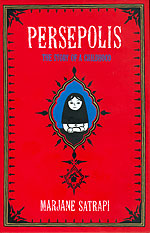
|
Marjane Satrapi spent the first fourteen years of her life in Tehran, as the daughter of well-educated, middle-class, left-wing parents. At the beginning of "Persepolis," she recalls her early obsession with becoming God's new Prophet. Practically personifying her country's sacred-secular struggle, she would decree that their maid could eat at the table with them and that her father's Cadillac would be banned. While her parents demonstrated against the Shah, Satrapi would march around the backyard with her friends, pretending to be Che Guevara. Like Satrapi, I was nine when the Shah fell in 1979. That the so-called "Islamic Revolution" began as a populist revolt that included secular, left-wing socialists is just one of this book's many surprises for someone like myself . The celebrations of the revolution take on a bittersweetness when imprisoned members of Satrapi's family are freed and return with tales of torture and murder.
Then things start to go badly.
The co-educational French school Marjane attends is shut down and she is sent to an Islamic girls' school. Both she and her mother are required to wear scarves over their hair. They publicly protest, along with many other women, until they are attacked by fundamentalist thugs. Roving "Guardians" make sure citizens (mostly women) follow the rules. Meanwhile the universities are closed, a beloved uncle is executed as a Soviet spy, and the borders are sealed. Typical of the surprises this book has for American readers, the occupation of the U.S. embassy, an act that demonized the Iranians for an entire generation of Americans, gets little attention. "I couldn't care less," says Satrapi's weary mother.
 Marjam Satrapi buys an illegal tape and gets stopped by the Guardians of the Revolution
Marjam Satrapi buys an illegal tape and gets stopped by the Guardians of the Revolution |
Then the war with Iraq starts, and the last third of "Persepolis" tells of its domestic ramifications. Tehran, where Satrapi lived, soon became a target for bombing and eventually for scud missiles. One day the maid arrives with a plastic, gold-painted key given to her son in school. "They told the boys that if they went to war and were lucky enough to die, this key would get them into heaven." A cousin from the front lines confirms the use of underclass children as mine fodder. One chilling page depicts the silhouettes of exploding bodies with keys around their necks contrasted with the panel below, of Satrapi and friends jumping around at a party.
The artwork in "Persepolis" has a simplicity that resonates with having a child as its main character. Unlike the complex nuances of the story, the artistic details are minimal and shading is non-existent. Instead the artwork of "Persepolis" takes on a wood-cut look. Satrapi makes wonderful use of solid, high-contrast black shapes. Veteran readers of quality comix will immediately think of David B.'s masterful "Epileptic I" (see TIME.comix review) of last year. Both books are childhood memoirs done in similar styles, though David B. has the greater graphic skill. In fact both authors are part of the same French cartoonist collective, L'association. "Persepolis" first appeared in France in 2000.
While the artistry and revelations of "Persepolis" already make it a required read, it has taken on even more importance in the current geopolitical climate. Written with astonishing detail and from the point of view of a child, "Persepolis" domesticates world events and makes them relatable and real. It pulls back the veil on a culture that utterly preoccupies us, but about which we know little. Its complicated personal portrait makes it impossible to think of Iran as the monolithic fundamentalist terror state of our fears.
Thanks to its timeliness and its subject, Marjane Satrapi's "Persepolis" makes for one of the most vital and surprising reads of the season. That she did it as a graphic memoir says a lot about the growth of this art-form. You could, and should, easily get a younger teenager to read it. Sometimes funny and sometimes sad but always sincere and revealing, "Persepolis" will be one of the best graphic books of the year.
"Persepolis" can be found at regular bookstores and superior comic stores.
